《生物化学》课程PPT教学课件(留学生)Chapter 06 Bioenergetics and Oxidative Phosphorylation
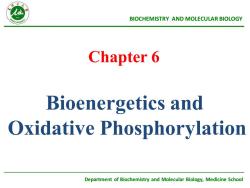
BIOCHEMISTRYANDMOLECULARBIOLOGYChapter 6Bioenergetics andOxidative PhosphorylationDepartment of Biochemistry and Molecular Biology,Medicine School
Department of Biochemistry and Molecular Biology, Medicine School BIOCHEMISTRY AND MOLECULAR BIOLOGY Chapter 6 Bioenergetics and Oxidative Phosphorylation

ABIOCHEMISTRYANDMOLECULARBIOLOGYOutline*Overview*Free energy change*Electron transport chain*Oxidativephosphorylation*ShuttleDepartment of Biochemistry and Molecular Biology,Medicine School
Department of Biochemistry and Molecular Biology, Medicine School BIOCHEMISTRY AND MOLECULAR BIOLOGY Outline *Overview *Free energy change *Electron transport chain *Oxidative phosphorylation *Shuttle
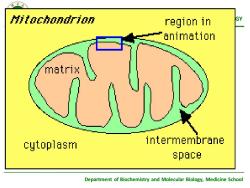
GY特好力O#行region inanimatiormatrixintermermbranecytoplasmspaceDepartment of Biochemistry and Molecular Biology,Medicine School
Department of Biochemistry and Molecular Biology, Medicine School BIOCHEMISTRY AND MOLECULAR BIOLOGY
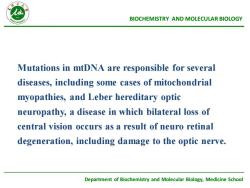
BIOCHEMISTRYANDMOLECULARBIOLOGYMutationsin mtDNAare responsible for severaldiseases, including some cases of mitochondrialmyopathies,and Leber hereditary opticneuropathy,a disease in which bilateral loss ofcentral vision occurs as a result of neuro retinaldegeneration, including damage to the optic nerve.Department of Biochemistry and Molecular Biology,Medicine School
Department of Biochemistry and Molecular Biology, Medicine School BIOCHEMISTRY AND MOLECULAR BIOLOGY Mutations in mtDNA are responsible for several diseases, including some cases of mitochondrial myopathies, and Leber hereditary optic neuropathy, a disease in which bilateral loss of central vision occurs as a result of neuro retinal degeneration, including damage to the optic nerve
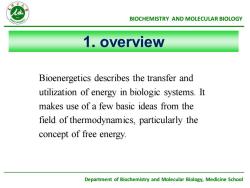
山BIOCHEMISTRYANDMOLECULARBIOLOGY1.overviewBioenergetics describes the transfer andutilization of energy in biologic systems. Itmakes use of a few basic ideas from thefield of thermodynamics, particularly theconcept of free energy.Department of Biochemistry and Molecular Biology,Medicine School
Department of Biochemistry and Molecular Biology, Medicine School BIOCHEMISTRY AND MOLECULAR BIOLOGY Bioenergetics describes the transfer and utilization of energy in biologic systems. It makes use of a few basic ideas from the field of thermodynamics, particularly the concept of free energy. 1. overview
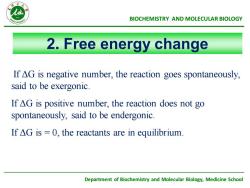
BIOCHEMISTRYANDMOLECULARBIOLOGY2.Free energy changeIf G is negative number, the reaction goes spontaneouslysaid to be exergonic.If △G is positive number, the reaction does not gospontaneously, said to be endergonicIf △G is = O, the reactants are in equilibriumDepartment of Biochemistry and Molecular Biology,Medicine School
Department of Biochemistry and Molecular Biology, Medicine School BIOCHEMISTRY AND MOLECULAR BIOLOGY If ΔG is negative number, the reaction goes spontaneously, said to be exergonic. If ΔG is positive number, the reaction does not go spontaneously, said to be endergonic. If ΔG is = 0, the reactants are in equilibrium. 2. Free energy change
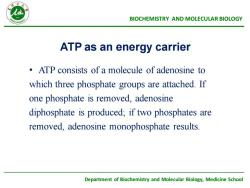
BIOCHEMISTRYANDMOLECULARBIOLOGYATPasanenergycarrier.ATP consists of amolecule of adenosine towhich three phosphate groups are attached. Ifone phosphate is removed, adenosinediphosphate is produced; if two phosphates areremoved, adenosine monophosphate resultsDepartment of Biochemistry and Molecular Biology,Medicine School
Department of Biochemistry and Molecular Biology, Medicine School BIOCHEMISTRY AND MOLECULAR BIOLOGY ATP as an energy carrier • ATP consists of a molecule of adenosine to which three phosphate groups are attached. If one phosphate is removed, adenosine diphosphate is produced; if two phosphates are removed, adenosine monophosphate results
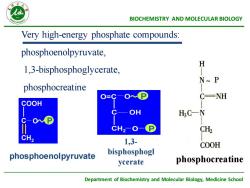
BIOCHEMISTRYANDMOLECULARBIOLOGYVery high-energy phosphate compounds:phosphoenolpyruvate,H1,3-bisphosphoglycerate,N~ PphosphocreatineCNHO=CCOOHOHHCNP0C-CH2-CH2CCH21,3-COOHbisphosphoglphosphoenolpyruvatephosphocreatineycerateDepartment of Biochemistry and Molecular Biology,Medicine School
Department of Biochemistry and Molecular Biology, Medicine School BIOCHEMISTRY AND MOLECULAR BIOLOGY Very high-energy phosphate compounds: phosphoenolpyruvate, 1,3-bisphosphoglycerate, phosphocreatine phosphoenolpyruvate COOH C CH2 O P 1,3- bisphosphogl ycerate O=C C OH CH2 O P O P phosphocreatine
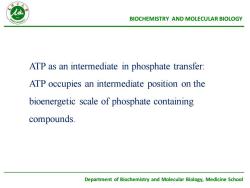
BIOCHEMISTRYANDMOLECULARBIOLOGYATP as an intermediate in phosphate transfer:ATP occupies an intermediate position on thebioenergetic scale of phosphate containingcompounds.Department of Biochemistry and Molecular Biology,Medicine School
Department of Biochemistry and Molecular Biology, Medicine School BIOCHEMISTRY AND MOLECULAR BIOLOGY ATP as an intermediate in phosphate transfer: ATP occupies an intermediate position on the bioenergetic scale of phosphate containing compounds
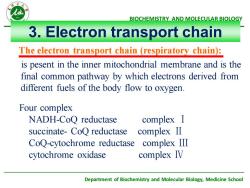
BIOCHEMISTRYANDMOLECULARBIOLOGY3.Electrontransport chainThe electron transport chain (respiratory chain):is pesent in the inner mitochondrial membrane and is thefinal common pathway by whichelectrons derived fromdifferent fuels of the body flow to oxygen.Fourcomplexcomplex INADH-CoQreductasecomplex IIsuccinate-CoQreductasecomplex IIICoQ-cytochromereductasecomplex IVcytochrome oxidaseDepartment of Biochemistry and Molecular Biology,Medicine School
Department of Biochemistry and Molecular Biology, Medicine School BIOCHEMISTRY AND MOLECULAR BIOLOGY The electron transport chain (respiratory chain): is pesent in the inner mitochondrial membrane and is the final common pathway by which electrons derived from different fuels of the body flow to oxygen. 3. Electron transport chain Four complex NADH-CoQ reductase complex Ⅰ succinate- CoQ reductase complex Ⅱ CoQ-cytochrome reductase complex Ⅲ cytochrome oxidase complex Ⅳ
按次数下载不扣除下载券;
注册用户24小时内重复下载只扣除一次;
顺序:VIP每日次数-->可用次数-->下载券;
- 《生物化学》课程PPT教学课件(留学生)Chapter 22 Amino acids - metabolism of carbon skeletons.ppt
- 《生物化学》课程PPT教学课件(留学生)Chapter 33 Molecular Basis of Inherited Disease.ppt
- 《生物化学》课程PPT教学课件(留学生)Chapter 09 Tricarboxylic Acid Cycle.ppt
- 《生物化学》课程PPT教学课件(留学生)Chapter 10 Gluconeogenesis.ppt
- 《生物化学》课程PPT教学课件(留学生)Chapter 28 Vitamins.ppt
- 《生物化学》课程教学资源(文献资料)Lehninger Principles of Biochemistry,5th EDITION,David L. Nelson、Michael M. Cox.pdf
- 《生物化学》课程教学资源(文献资料)临床医本考试大纲.doc
- 《生物化学》课程教学资源(文献资料)临床医本实验大纲 Biochemistry Experiment.doc
- 《生物化学》课程教学资源(文献资料)实验教程.doc
- 《生物化学》课程教学资源(教案讲义)蛋白质的结构与功能.doc
- 《生物化学》课程教学资源(教案讲义)DNA的生物合成.doc
- 《生物化学》课程教学资源(教案讲义)糖代谢.doc
- 《生物化学》课程教学资源(教案讲义)细胞信息转导.doc
- 《生物化学》课程教学资源(文献资料)CURRICULUM FOR UNDER-GRADUATE MEDICAL EDUCATION IN BANGLADESH 2002.pdf
- 《生物化学》课程教学资源(文献资料)Harper’s Illustrated Biochemistry,26th edition,Robert K. Murray Daryl K. Granner Peter A. Mayes Victor W. Rodwell.pdf
- 《生物化学》课程教学资源(文献资料)Syllabus MBBS at the AIIMS(印度).pdf
- 《生物化学》课程教学资源(试卷习题)2012-护理本科-B卷-题目.doc
- 《生物化学》课程教学资源(试卷习题)2012级本科-B卷-题目.doc
- 《生物化学》课程教学资源(试卷习题)2012-护理本科-B卷-答案.doc
- 《生物化学》课程教学资源(试卷习题)2012级本科-B卷-答案.doc
- 《生物化学》课程PPT教学课件(留学生)Chapter 21 Amino acids - disposal of nitrogen.ppt
- 《生物化学》课程PPT教学课件(留学生)Chapter 07 Introduction of Carbohydrates.ppt
- 《生物化学》课程PPT教学课件(留学生)Chapter 15 glycosaminoglycans.ppt
- 《生物化学》课程PPT教学课件(留学生)Chapter 14 Metabolism of monosaccharides and disaccharides.ppt
- 《生物化学》课程PPT教学课件(留学生)Chapter 01 Amino Acids(structure of amino acid、acid/base properties of amino acid).ppt
- 《生物化学》课程PPT教学课件(留学生)Chapter 01 Amino Acids(overview).ppt
- 《生物化学》课程PPT教学课件(留学生)Chapter 31 Structure and Function of RNA.ppt
- 《生物化学》课程PPT教学课件(留学生)Chapter 20 The metabolism of cholesterol.ppt
- 《生物化学》课程PPT教学课件(留学生)Chapter 29 Metabolism of Nucleotides.ppt
- 《生物化学》课程PPT教学课件(留学生)Chapter 18 phospholipid metabolism.ppt
- 《生物化学》课程PPT教学课件(留学生)Chapter 19 glycolipid metabolism.ppt
- 《生物化学》课程PPT教学课件(留学生)Chapter 32 Biosynthesis of Protein.ppt
- 《生物化学》课程教学资源(PPT课件)18 维生素 Vitamins.ppt
- 《生物化学》课程教学资源(PPT课件)16 血液的生物化学 Hemal Biochemistry.ppt
- 《生物化学》课程教学资源(PPT课件)17 肝的生物化学 Biochemistry in Liver.ppt
- 《生物化学》课程PPT教学课件(留学生)Chapter 30 DNA Structure and Replication.ppt
- 《生物化学》课程教学资源(PPT课件)13 基因表达调控 Regulation of Gene Expression.ppt
- 《生物化学》课程教学资源(PPT课件)15 信号转导(细胞信息传递 Cell Communication and Signal Transduction).ppt
- 《生物化学》课程教学资源(PPT课件)14 基因重组与基因工程 Genetic Recombination and Genetic Engineering.ppt
- 《生物化学》课程教学资源(PPT课件)09 物质代谢的联系与调节 Metabolic Interrelationships and Regulation.ppt
